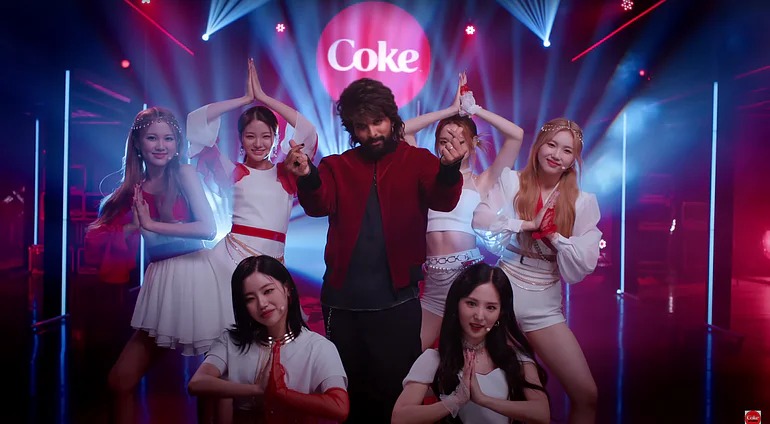Allu Arjun, the Telugu actor, appears in Indian advertising alongside the South Korean pop group TRI.BE and the North Indian vocalist Armaan Malik for the first time. Arjun is the star of a lengthy, over two-minute music video that promotes Coca-Cola. In the past, celebrities including Aishwarya Rai, Aamir Khan, Ranbir Kapoor, Hrithik Roshan, and Siddharth Malhotra have all endorsed Coca-Cola.
What distinguishes Arjun from the actors named above? Except for Aishwarya Rai, these are all Bollywood actors who haven’t appeared in any South Indian films. Arjun, on the other hand, primarily works in Telugu cinema and has never appeared in a Hindi-language film.
How does Arjun now compare to the actors who once endorsed these brands? His most recent blockbuster, Pushpa: The Rise, which was released in December 2021, has some of the answers. This Telugu film, which was originally dubbed into several other Indian languages, became a massive blockbuster all throughout the nation.
Thanks to Pushpa’s popularity, Arjun is now a national star instead of a regional actor. One who is well-known and has subsequently supported popular products like Parle Agro’s Frooti, KFC, Zomato, and Rapido. He selects these endorsement deals at random. According to media sources, he recently declined an endorsement agreement with a pan masala company that would have paid him close to Rs. 10 crore.
Arjun declining the endorsement is not shocking to Manish Porwal, managing director of Alchemist Marketing and Talent Solutions. He probably would have received a trolling if he had accepted the ripe offer. He is a famous actor. When people appreciate an actor, especially in the South, they become devoted followers, and the celebrity has a huge impact on them. According to him, Arjun’s appeal to fans is comparable to that of some of India’s finest actors.
The fact that his rejection of the endorsement made headlines didn’t surprise Dr. Sandeep Goyal, Rediffusion MD and founder of the Indian Institute of Human Brands. Without appearing in a Hindi film, he claims, Pushpa has helped Allu Arjun achieve familiarity, popular appeal, and all-India recognition.
Goyal makes a point of mentioning that Arjun hasn’t appeared in any Bollywood films because, in the past, that was the most common way for a South Indian actor to gain recognition throughout the nation.
According to Porwal, the gap between the North and the South is closing, and trans-regional films are now succeeding across India. If one looks at films like Pushpa or the Baahubali saga, they have performed incredibly well across India, and this is a trend that will continue to increase, he says.
According to N. Chandramouli, CEO of TRA Research, Telugu films are popular with people who do not speak the language because of their high production values, exciting action scenes, memorable dance numbers, etc. Audiences today don’t care what language a film was shot in. He claims they will watch it if it’s enjoyable and has a compelling plot.
Recognition, familiarity, and mass appeal play a crucial role in a star’s ability to participate in the brand endorsement game, claims Goyal.
Goyal continues by saying that Pushpa’s success has raised Arjun’s worth as a brand endorser. He discloses that Ranveer Singh asks for at least Rs. 6 crore and offers the company at least two days of his time, compared to Allu Arjun’s estimated Rs. 7.5 crore per endorsement agreement.
According to Porwal, Arjun will benefit from the success of his films by receiving a higher yield on each agreement. South Indian actors frequently choose their endorsements carefully. There is a significant premium when it comes to endorsements because renowned actors like Rajinikanth and Kamal Hassan, for many years, refused to do brand endorsements at all. He adds that brands are more likely to provide Arjun with better value for his money.
Brand consultant Abhimanyu Mishra from Brandfizz opines that brands are increasingly leveraging South Indian stars for advertisements that span all of India, reversing their previous practise of using regional celebrities for regionally focused campaigns.
The tendency not only distorts the cultural barrier between the North and South but also brings in big bucks for marketers by sparing them the expense of hiring several brand ambassadors and productions for a pan-Indian campaign.




